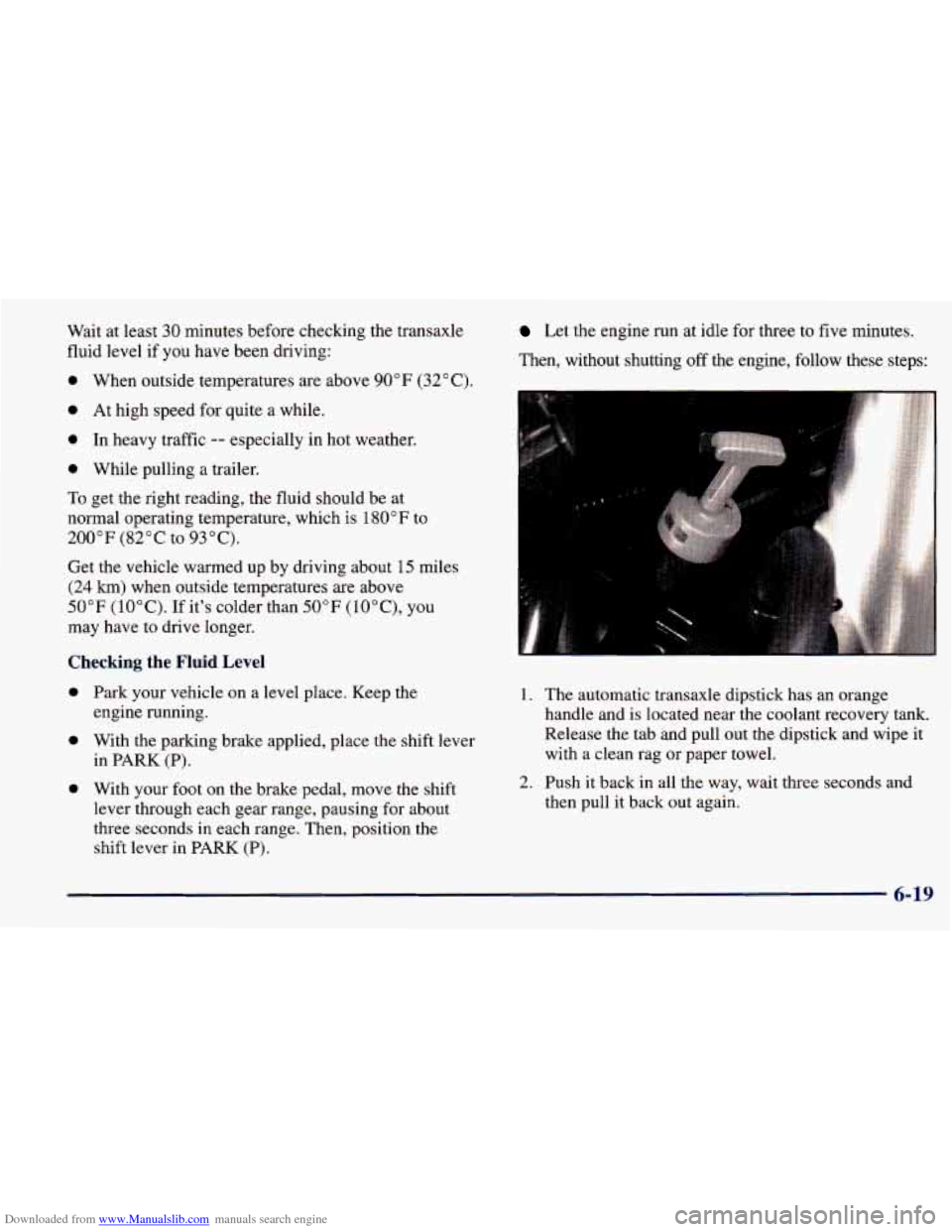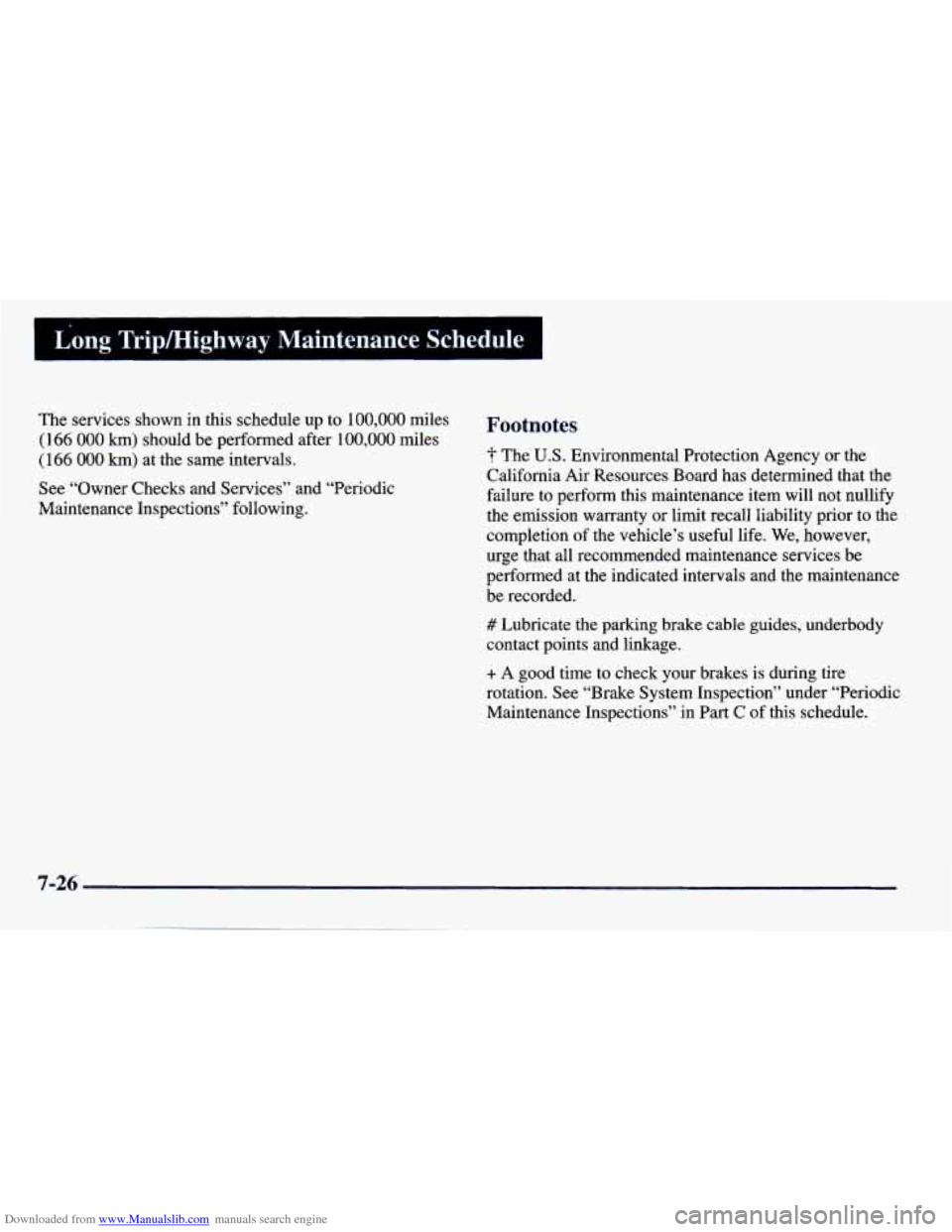1998 CHEVROLET PRIZM parking brake
[x] Cancel search: parking brakePage 245 of 364

Downloaded from www.Manualslib.com manuals search engine Wait at least 30 minutes before checking the transaxle
fluid level if you have been driving:
0 When outside temperatures are above 90°F (32°C).
0 At high speed for quite a while.
0 In heavy traffic -- especially in hot weather.
0 While pulling a trailer.
To get the right reading, the fluid should be at
normal operating temperature, which is
180°F to
200°F (82°C to 93°C).
Get the vehicle warmed up by driving about 15 miles
(24 km) when outside temperatures are above
50°F (10°C). If it's colder than 50°F ( 10°C), you
may have to drive longer.
Checking the Fluid Level
0 Park your vehicle on a level place. Keep the
0 With the parking brake applied, place the shift lever
0 With your foot on the brake pedal, move the shift
lever through each gear range, pausing for about
three seconds
in each range. Then, position the
shift lever
in PARK (P).
engine running.
in PARK (P)
.
Let the engine run at idle for three to five minutes.
Then, without shutting
off the engine, follow these steps:
1. The automatic transaxle dipstick has an orange
handle and
is located near the coolant recovery tank.
Release the tab and pull
out the dipstick and wipe it
with a clean rag or paper towel.
then pull it back out again.
2. Push it back in all the way, wait three seconds and
6-19
Page 294 of 364

Downloaded from www.Manualslib.com manuals search engine I Short TripKity Maintenance Schedule I
The services shown in this schedule up to 100,000 miles
(166 000 km) should be performed after 100,000 miles
(166 000 km) at the same intervals.
See “Owner Checks and Services” and “Periodic
Maintenance Inspections” following.
Footnotes
-f The U.S. Environmental Protection Agency or the
California Air Resources Board has determined that the
failure to perform this maintenance item will not nullify
the emission warranty or limit recall liability prior to the
completion of the vehicle’s useful life. We, however,
urge
that all recommended maintenance services be
performed at the indicated intervals and the maintenance
be recorded.
# Lubricate the parking brake cable guides, underbody
contact points and linkage.
+ A good time to check your brakes is during tire
rotation. See “Brake System Inspection” under “Periodic
Maintenance Inspections” in Part
C of this schedule.
7-8
Page 312 of 364

Downloaded from www.Manualslib.com manuals search engine Long Tripmighway P“aintenance Schedule
The services shown in this schedule up to 100,000 miles
(166
000 km) should be performed after 100,000 miles
(166 000 km) at the same intervals.
See “Owner Checks and Services” and “Periodic
Maintenance Inspections” following.
Footnotes
The U.S. Environmental Protection Agency or the
California Air Resources Board has determined that the
failure to perform this maintenance item will not nullify the emission warranty
or limit recall liability prior to the
completion
of the vehicle’s useful life. We, however,
urge that all recommended maintenance services be
performed at the indicated intervals and the maintenance
be recorded.
# Lubricate the parking brake cable guides, underbody
contact points and linkage.
+ A good time to check your brakes is during tire
rotation. See “Brake System Inspection” under “Periodic
Maintenance Inspections’’ in Part
C of this schedule.
7-26
Page 325 of 364

Downloaded from www.Manualslib.com manuals search engine At Least Once a Year
Key Lock Cylinders Service
Lubricate the key lock cylinders with the lubricant
specified in Part
D.
Seat 01 ion Check
Make sure the head restraints stay in position and all
seat latches lock. Check that the recliner holds by
pushing and pulling the seatback while it
is reclined.
Body Lubrication Service
Lubricate all body door hinges. Also lubricate all
hinges and latches, including those for the hood, secondary latches, rear compartment and any folding
seat hardware. Part
D tells you what to use. More
frequent lubrication may be required when exposed to
a corrosive environment.
Starter Switch Check
When you are doing this check, tne vehicle could
move suddenly.
If it does, you or others could be
injured. Follow the steps below.
1. Before you start, be sure you have enough room
around the vehicle.
2. Firmly apply both the parking brake (see “Parking
Brake” in the Index if necessary) and the regular brake.
NOTE: Do not use the accelerator pedal, and be
ready to turn off the engine immediately if it starts.
3. On automatic transaxle vehicles, try to start the
engine
in each gear. The starter should work only in
PARK (P) or NEUTRAL (N). If the starter works in
any other position, your vehicle needs service.
On manual transaxle vehicles, put the shift lever in
NEUTRAL (N), push the clutch down halfway and
try to start the engine. The starter should work only
when the clutch is pushed down all the way
to the
floor. If the starter works when the clutch isn’t
pushed all the way down, your vehicle
needs service.
7-39
Page 326 of 364

Downloaded from www.Manualslib.com manuals search engine Brake-Transaxle Shift Interlock (BTSI) Check (Automatic Transaxle) Ignition Transaxle Lock Check
While parked, and
with the parking brake set, try to turn
the ignition key to
LOCK in each shift lever position.
r
With an automatic transaxle, the key should turn to
LOCK only when the shift lever is in PARK (P).
LOCK only if you push the key in farther, while
turning it towards
LOCK.
When you are doing this check, the vehicle could With a manual transaxle, the key should turn to
move suddenly. If it does, you or others could be
injured. Follow the steps below.
1. Before you start, be sure you have enough room
around the vehicle. It should be parked
on a
level surface.
2. Firmly apply the parking brake (see “Parking Brake”
in the Index if necessary).
NOTE: Be ready
to apply the regular brake
immediately if the vehicle begins
to move.
3. With the engine off, turn the key to the ON position,
but don’t start the engine. Without applying the
regular brake,
try to move the shift lever out of
PARK (P) with normal effort. If the shift lever
moves out
of PARK (P), your vehicle’s BTSI
needs service.
7-40
Page 327 of 364

Downloaded from www.Manualslib.com manuals search engine Parking Brake and Automatic Transaxle PARK (P)
Mechanism Check
-
’ A CAUTdN:
When you are doing this check, your vehicle
could begin to move.
You or others could be
injured and property could be damaged. Make
sure there is room in front
of your vehicle in case
it begins to roll. Be ready to apply the regular
brake
at once should the vehicle begin to move.
Park on a fairly steep hill, with the vehicle facing
downhill. Keeping your foot
on the regular brake, set
the parking brake.
To check the parking brake’s holding ability: With
the engine running and transaxle in NEUTRAL
(N),
slowly remove foot pressure from the regular brake
pedal.
Do this until the vehicle is held by the parking
brake only.
To check the PARK (P) mechanism’s holding ability:
With the engine running, shift to PARK (P). Then
release all brakes.
Underbody Flushing Service
At least every spring, use plain water to flush any
corrosive materials from the underbody. Take care to
clean thoroughly any areas where mud and other
debris can collect.
7-41
Page 329 of 364

Downloaded from www.Manualslib.com manuals search engine Throttle System Inspection
Inspect the throttle system for interference or binding,
and for damaged or missing parts. Replace parts as
needed. Replace any components that have high effort
or excessive wear.
Do not lubricate accelerator and
cruise control cables.
Brake System Inspection
Inspect the complete system. Inspect brake lines and
hoses for proper hook-up, binding, leaks, cracks,
chafing, etc. Inspect disc brake pads for wear and rotors
for surface condition. Also inspect drum brake linings
for wear and cracks. Inspect other brake parts, including
drums, wheel cylinders, calipers, parking brake, etc.
Check parking brake adjustment. You may need to have
your brakes inspected more often if your driving habits
or conditions result in frequent braking.
7-43
Page 349 of 364

Downloaded from www.Manualslib.com manuals search engine 0 Section 9 Index
Adding Equipment to the Outside of Your Vehicle ..... 6-3
AirBag
....................................... 1-21
How Does it Restrain .......................... 1-27
How it Works ................................ 1-24
Location
.................................... 1-24
Readiness Light
......................... 1.23. 2.46
Servicing
................................... 1-29
What Makes
it Inflate .......................... 1-26
What Will You See After it Inflates
............... 1-27
When Should it Inflate
......................... 1-26
Aircleaner
............................... 6.16. 6.60
Air Conditioning Refrigerants
................ 6.59. 6.60
Alignment and Balance. Tire
...................... 6-42
Antenna
...................................... 3-17
Antifreeze
..................................... 6-23
Anti-Lock Brake System Warning Light
................ 2.48. 4.7
Brakes
...................................... 4-7
Appearancecare
............................... 6-44
Appearance Care Materials
....................... 6-52
Arbitration Program
.............................. 8-9
Ashtrays
...................................... 2-38
Audio Systems
.................................. 3-6
Automatic Light Control
......................... 2-33
Automatic Transaxle Fluid
....................................... 6-18
Air Conditioning
................................ 3-3
Fluid Level Check
............................ 7-38
Operation
................................... 2-14
Park Mechanism Check
........................ 7-41
Starting Your Engine
.......................... 2-13
Backing Up While Driving a Trailer
............... 4-35
Back-up Lamp Bulb Replacement
................. 6-36
Battery
....................................... 6-32
Jump Starting ................................. 5-3
Replacement. Keyless Entry
..................... 2-8
Warnings
................................ 5.3. 5.5
BBB Auto Line ................................. 8-9
Better Business Bureau Mediation
................... 8-9
Blizzard
...................................... 4-26
Brake Adjustment
.................................. 6-32
Fluid
....................................... 6-28
Master Cylinder
.............................. 6-28
Parking
..................................... 2-20
PedalTravel
................................. 6-31
Replacing System Parts
........................ 6-32
System Warning Light
......................... 2-47
Trailer
...................................... 4-34
Transaxle Shift Interlock
.................. 2.22. 7.40
Transaxle Shift Interlock Check
.................. 7-40
Wear
....................................... 6-31
9-1